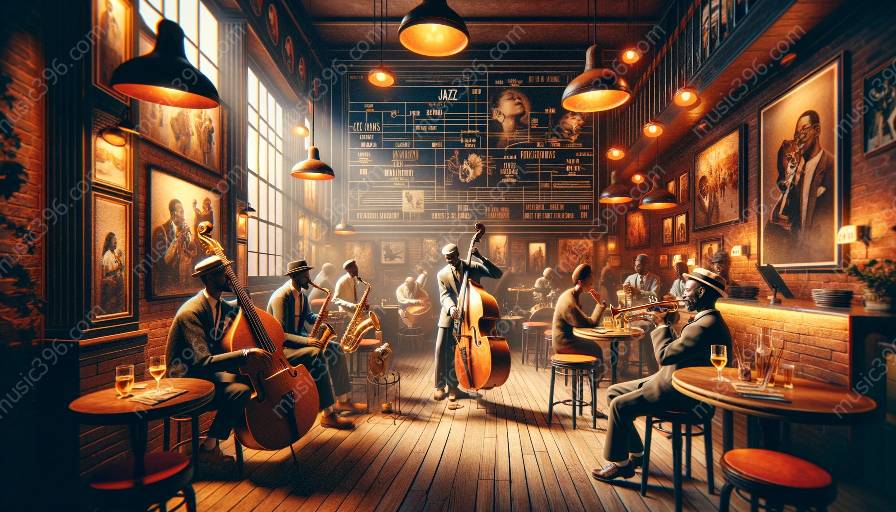Jazz music, recognized for its improvisational nature and syncopated rhythms, has had a profound impact on the realms of visual arts and literature. This influence spans from the early 20th century to the present day, fostering the convergence of artistic expressions, cultural movements, and social change. Exploring the connection between jazz and the visual arts reveals a symbiotic relationship, as artists have drawn inspiration from the music's energy, spontaneity, and emotional depth. Similarly, the impact of jazz on literature has resulted in a rich tapestry of literary works that capture the essence of the music and its societal impact.
The Birth of Jazz and Its Impact
Jazz emerged as a distinctly American musical genre in the late 19th and early 20th centuries, rooted in the cultural amalgamation of African rhythms, European harmonies, and American improvisational techniques. Originating in the African American communities of New Orleans, jazz quickly became a significant cultural force, crossing racial and social barriers to captivate audiences worldwide. The unique blend of influences within jazz, coupled with its dynamic and expressive qualities, inspired a new wave of creativity in various artistic disciplines.
Jazz and the Visual Arts
The visual arts experienced a notable transformation as a result of jazz's impact. The music's improvisational spirit and unconventional rhythms prompted visual artists to explore new forms of expression, resulting in the birth of movement such as jazz-inspired painting, sculpture, and collage. The works of artists like Stuart Davis, Romare Bearden, and Jackson Pollock exemplify the dynamic relationship between jazz and the visual arts.
Stuart Davis, a prominent figure in the American modernist movement, drew inspiration from the syncopated rhythms and vibrant energy of jazz music. His paintings, including 'Swing Landscape,' reflect the pulsating, rhythmic quality of jazz through bold colors and dynamic forms, mirroring the improvisational nature of the music itself.
Romare Bearden, known for his collage-based artworks, integrated elements of jazz culture into his visual compositions. His vibrant collages, such as 'The Prodigal Son,' capture the essence of jazz through fragmented imagery and rhythmic layering, reflecting the polyphonic complexities of the music.
Jackson Pollock, a pivotal figure in the abstract expressionist movement, channelled the energy and spontaneity of jazz into his iconic drip paintings. The rhythmic, gestural nature of Pollock's work mirrors the improvisational qualities of jazz music, forging a direct connection between visual and auditory modes of expression.
The influence of jazz on the visual arts extended beyond individual artists, permeating art movements such as the Harlem Renaissance and the Beat Generation. As jazz evolved, so did the visual representations of its influence, resulting in a diverse array of artistic expressions that continue to resonate with audiences today.
Jazz and Literature
Literature, too, felt the reverberations of jazz's impact, as writers incorporated the music's ethos, rhythms, and thematic elements into their works. The vivid, improvisational nature of jazz inspired literary experimentation, resulting in a genre-bending fusion of storytelling, poetry, and social commentary.
Notably, the Harlem Renaissance became a crucible for literary voices enamored with jazz, giving rise to poets and authors who sought to capture the essence of the music within the written word. Writers such as Langston Hughes, Zora Neale Hurston, and Claude McKay infused jazz sensibilities into their works, creating a rich tapestry of literature that mirrored the syncopated rhythms and emotional fervor of the music.
Jazz's impact on literature transcended geographical boundaries, inspiring writers across the globe to explore the intersection of music and storytelling. The Beat Generation, with iconic figures like Jack Kerouac and Allen Ginsberg, embraced jazz as a literary muse, infusing their works with the improvisational, free-flowing spirit of the music. The result was a literary movement that mirrored the spontaneity and non-conformity of jazz, crafting a new narrative language that resonated with readers well beyond the era in which it emerged.
Legacy and Continued Influence
The profound influence of jazz on the visual arts and literature continues to reverberate throughout contemporary artistic expressions. As jazz music evolves and adapts to the changing cultural landscape, it remains a wellspring of inspiration for artists and writers alike, fostering a dialogue between mediums that transcends artistic boundaries and temporal constraints.
The symbiotic relationship between jazz, the visual arts, and literature underscores the transformative power of artistic collaboration and cross-pollination. Jazz's enduring legacy as a catalyst for creative innovation serves as a testament to its ability to transcend musical boundaries and inspire multifaceted artistic movements.





























